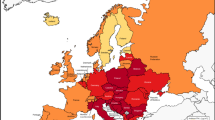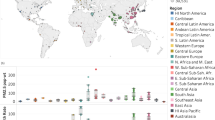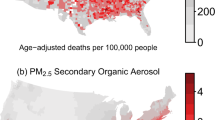Abstract
Multi-city population-based epidemiological studies have observed significant heterogeneity in both the magnitude and direction of city-specific risk estimates, but tended to focus on regional differences in PM2.5 mortality risk estimates. Interpreting differences in risk estimates is complicated by city-to-city heterogeneity observed within regions due to city-to-city variations in the PM2.5 composition and the concentration of gaseous pollutants. We evaluate whether variations in PM2.5 composition and gaseous pollutant concentrations have a role in explaining the heterogeneity in PM2.5 mortality risk estimates observed in 27 US cities from 1997 to 2002. Within each region, we select the two cities with the largest and smallest mortality risk estimate. We compare for each region the within- and between-city concentrations and correlations of PM2.5 constituents and gaseous pollutants. We also attempt to identify source factors through principal component analysis (PCA) for each city. The results of this analysis indicate that identifying a PM constituent(s) that explains the differences in the PM2.5 mortality risk estimates is not straightforward. The difference in risk estimates between cities in the same region may be attributed to a group of pollutants, possibly those related to local sources such as traffic.
This is a preview of subscription content, access via your institution
Access options
Subscribe to this journal
Receive 6 print issues and online access
$259.00 per year
only $43.17 per issue
Buy this article
- Purchase on Springer Link
- Instant access to full article PDF
Prices may be subject to local taxes which are calculated during checkout

Similar content being viewed by others
References
Franklin M, Zeka A, Schwartz J . Association between PM2.5 and all-cause and specific-cause mortality in 27 US communities. J Expo Sci Environ Epidemiol 2007; 17: 279–287.
Peng RD, Dominici F, Pastor-Barriuso R, Zeger SL, Samet JM . Seasonal analyses of air pollution and mortality in 100 US cities. Am J Epidemiol 2005; 161: 585–594.
Levy JI, Diez D, Dou Y, Barr CD, Dominici F . A meta-analysis and multisite time-series analysis of the differential toxicity of major fine particulate matter constituents. Am J Epidemiol 2012; 175: 1091–1099.
Davis JA, Meng Q, Sacks JD, Dutton SJ, Wilson WE, Pinto JP . Regional variations in particulate matter composition and the ability of monitoring data to represent population exposures. Sci Total Envir 2011; 409: 5129–5135.
Bell ML, Dominici F, Ebisu K, Zeger SL, Samet JM . Spatial and temporal variation in PM2.5 chemical composition in the United States for health effects studies. Environ Health Perspect 2007; 115: 989–995.
Dominici F, McDermott A, Zeger SL, Samet JM . National maps of the effects of particulate matter mortality: exploring geographic variation. Environ Health Perspect 2003; 111: 39–43.
Sarnat JA, Schwartz J, Catalano PJ, Suh HH . Gaseous pollutants in particulate matter epidemiology: confounders or surrogates? Environ Health Perspect 2001; 109: 1053–1061.
United States Environmental Protection Agency. Aerometric Information Retrieval Service (AIRS) Database 2009. http://www.epa.gov/air/data/info.html.
Blanchard CL, Carr EL, Collins JF, Smith TB, Lehrman DE, Michaels HM . Spatial representativeness and scales of transport during the 1995 integrated monitoring study in California’s San Joaquin Valley. Atmos Environ 1999; 33: 4775–4786.
Wilson JG, Kingham S, Pearce J, Sturman AP . A review of intraurban variations in particulate air pollution: Implication for epidemiological research. Atmos Environ 2005; 39: 6444–6462.
Rosner B . Fundamental of Biostatistics 5th edn Brooks/Cole: Pacific Grove, CA. 2000.
Beebe KR, Pell RJ, Seasholtz MB . Chemometrics: A Practical Guide. John Wiley &Sons: New York, NY. 1998.
United States Environmental Protection Agency. Integrated Science Assessment for Particulate Matter. Office of Research and Development, National Center for Environmental Assessment-RTP Division: Research Triangle Park, NC. 2009.
SAS Institute. Version 9.3 of the SAS System for Windows, Copyright 2002–2010. SAS Institute: Cary, NC, USA. 2011.
Bell ML, Ebisu K, Peng RD, Samet JM, Dominici F . Hospital admissions and chemical composition of fine particle air pollution. Am J Respir Crit Care Med 2009; 179: 1115–1120.
Franklin M, Koutrakis P, Schwartz J . The role of particle composition and the association between PM2.5 and mortality. Epidemiology 2008; 19: 680–689.
Bell ML, Ebisu K, Peng RD . Community-level spatial heterogeneity of chemical constituent levels of fine particulates and implications for epidemiological research. J Expo Sci Environ Epidemiol 2011; 21: 372–384.
Baxter L, Franklin M, Özkaynak H, Schultz B, Neas L . The use of improved exposure factors in the interpretation of fine particulate matter epidemiological results. Air Qual Atmos Health 2011;, 1–10.
Ostro B, Broadwin R, Green S, Feng WY, Lipsett M . Fine particulate air pollution and mortality in nine California counties: results from CALFINE. Environ Health Perspect 2006; 114: 29–33.
Ostro BD, Feng W-Y, Broadwin R, Malig BJ, Green RS, Lipsett MJ . The impact of components of fine particulate matter on cardiovascular mortality in susceptible subpopulations. Occup Environ Med 2008; 65: 750–756.
Zeka A, Zanobetti A, Schwartz J . Individual-level modifiers of the effects of particulate matter on daily mortality. Am J Epidemiol 2006; 163: 849–859.
Acknowledgements
We thank Lucas Neas of the US EPA’s National Health and Environmental Effects Research Laboratory. We would also like to thank Tom Luben of the US EPA’s National Center for Exposure Assessment and Kathie Dioniosio of the US EPA’s National Exposure Research Laboratory for their review of this paper.
DISCLAIMER
The United States Environmental Protection Agency through its Office of Research and Development funded and managed the research described here. It has been subjected to Agency's administrative review and approved for publication.
Author information
Authors and Affiliations
Corresponding author
Ethics declarations
Competing interests
The authors declare no conflict of interest.
Additional information
Supplementary Information accompanies the paper on the Journal of Exposure Science and Environmental Epidemiology website
Supplementary information
Rights and permissions
About this article
Cite this article
Baxter, L., Duvall, R. & Sacks, J. Examining the effects of air pollution composition on within region differences in PM2.5 mortality risk estimates. J Expo Sci Environ Epidemiol 23, 457–465 (2013). https://doi.org/10.1038/jes.2012.114
Received:
Revised:
Accepted:
Published:
Issue Date:
DOI: https://doi.org/10.1038/jes.2012.114
Keywords
This article is cited by
-
Investigating seasonal air quality variations consequent to the urban vegetation in the metropolis of Faisalabad, Pakistan
Scientific Reports (2024)
-
Investigating the association of environmental exposures and all-cause mortality in the UK Biobank using sparse principal component analysis
Scientific Reports (2022)
-
Variation in the concentrations of atmospheric PM2.5 and its main chemical components in an eastern China city (Hangzhou) since the release of the Air Pollution Prevention and Control Action Plan in 2013
Air Quality, Atmosphere & Health (2022)
-
Influence of exposure differences on city-to-city heterogeneity in PM2.5-mortality associations in US cities
Environmental Health (2017)
-
The elemental composition and origin of fine ambient particles in the largest Polish conurbation: first results from the short-term winter campaign
Theoretical and Applied Climatology (2016)



